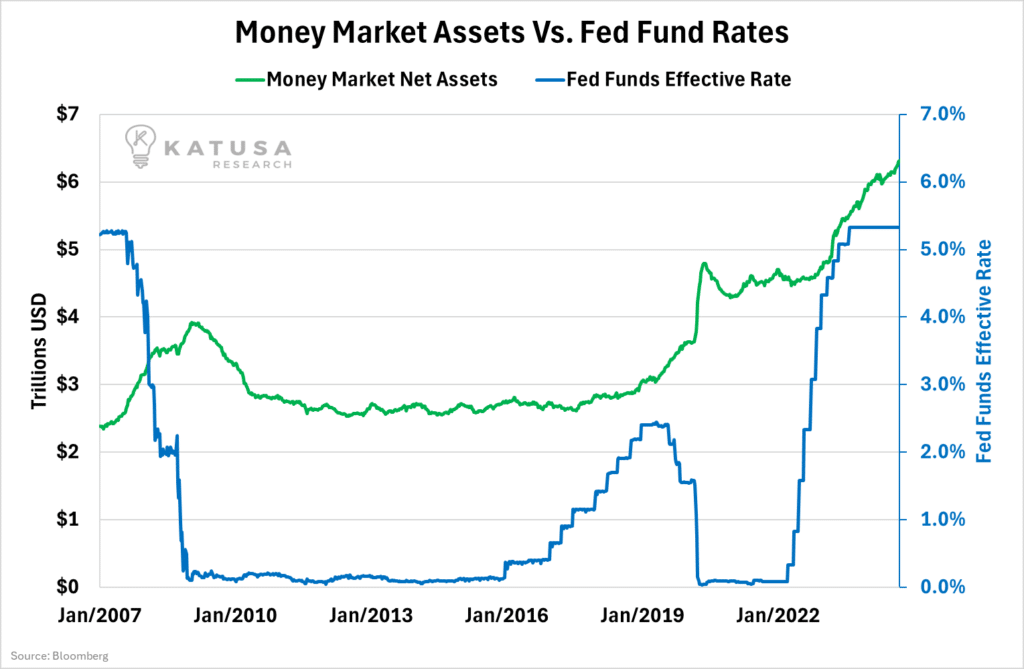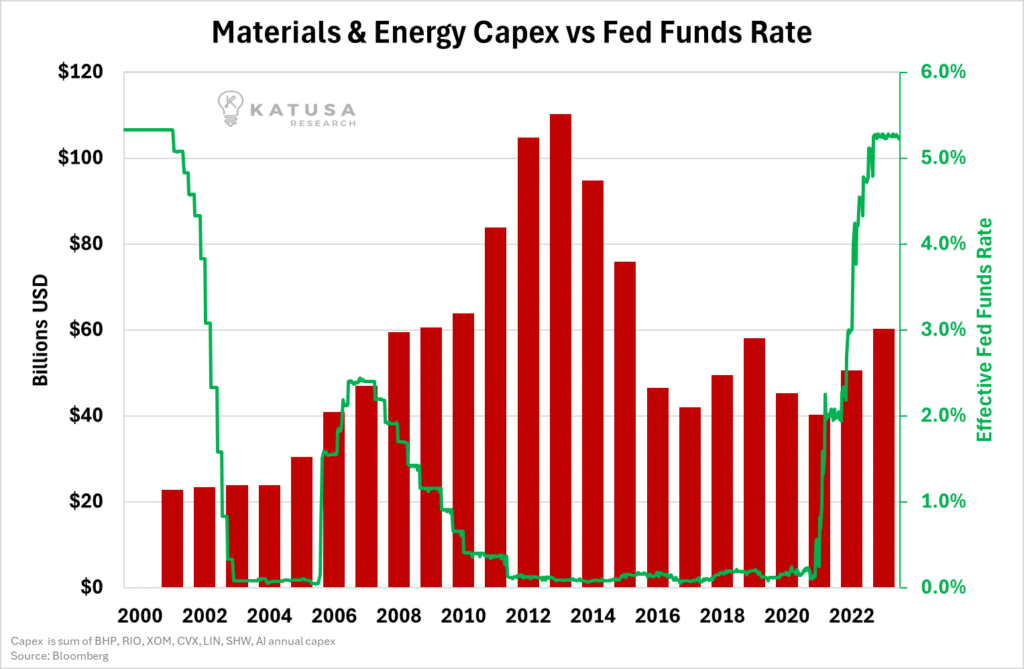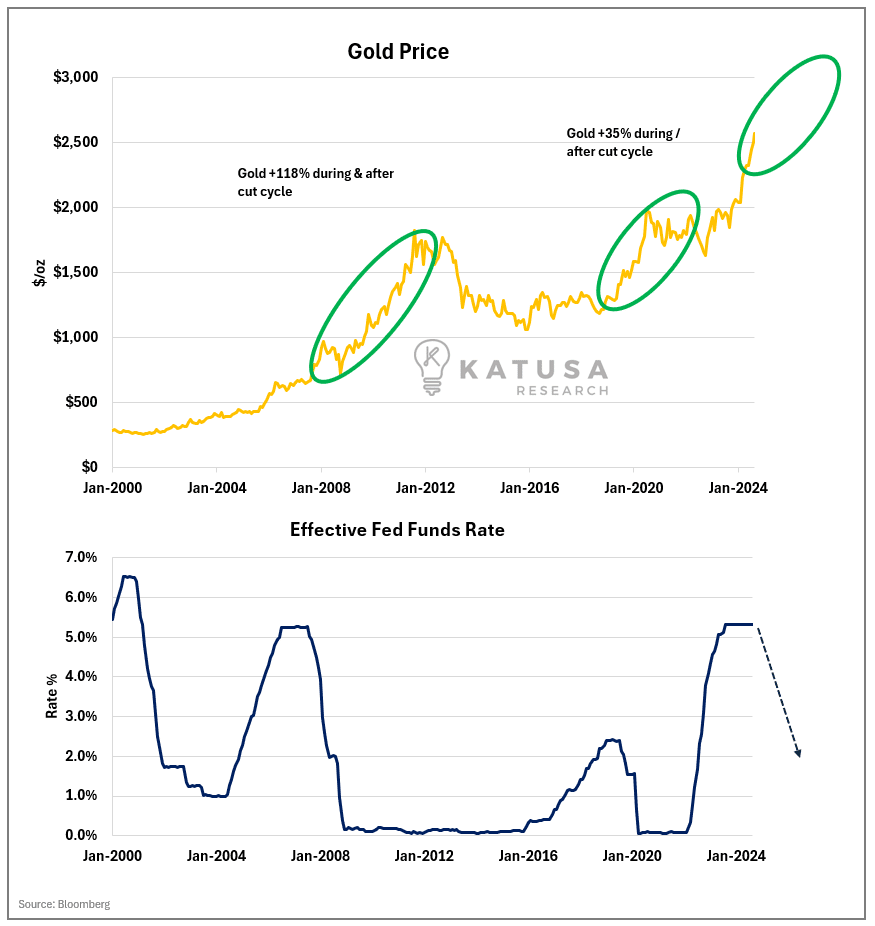This week’s Investment Insights is action packed:
- Rate Cuts are Here and Money is on the Move – With over $6 trillion sitting in money market funds, lower returns are coming fast. What does this mean for your cash?
- What Big Investors Do When Rates Drop – Warren Buffett and other market giants shift strategies to capitalize on the changing landscape. Find out where they’re putting their money.
- Why Oil Majors and Gold Are Poised for Growth – As borrowing costs fall, companies are gearing up for expansion, while gold could see a surge.
A 50 basis point cut was no surprise.
But that means a big change in thinking and sentiment that will affect everyone, from the small traders to the US Government.
Over the past few years, the “T-Bill and chill” approach to cash management triggered assets under management of money market funds to soar to all-time highs.
However, this time around, because rates went above 5% it triggered a slew of investors attracted by yields at decade highs, not because of economic uncertainty.

You’re reading the chart correctly. There is over $6 trillion sitting in money market funds, that are now going to start to see lower rates of return moving forward, for the first time in several years.
It’s no joke, I personally have a lot of my holdings in cash or near-cash funds that paid me just over 5% for nearly 2 years.
Those days are over.
Now, after years of 5%+ returns on cash, is it time to rotate out?
When Rates Come Down, What Do Big Investors Like Buffett and Paulson Do?
When interest rates decline, investors like Warren Buffett and others often reassess their investment strategies to capitalize on the changing economic environment.
Buffett does have a mega war chest of $578 billion in cash, equity and fixed income holdings.
Lower interest rates can have several effects:
- Shift Toward Equities: Reduced rates make borrowing cheaper for companies, potentially boosting corporate profits and making stocks more attractive. Investors might increase their equity holdings, focusing on companies poised to benefit from the lower cost of capital.
- Seek Higher Yields Elsewhere: With bond yields decreasing, investors may look for alternative investments offering better returns, such as dividend-paying stocks, real estate, or high-quality corporate bonds.
Now for some words that are turn-ons for analysts and investment bankers…
What Do Lower Rates Mean for Valuations of Companies…
Generally, when interest rates come down, the valuations of companies tend to go up.
Here’s why:
- Lower Discount Rates: In valuation models like the discounted cash flow (DCF) analysis, future cash flows are discounted back to their present value using a discount rate often influenced by prevailing interest rates. A lower discount rate increases the present value of these future cash flows, leading to higher valuations.
- Cheaper Borrowing Costs: Companies can borrow money at lower rates, reducing their interest expenses and potentially increasing net profits. This improvement in profitability can make a company more valuable.
- Investor Behavior: Lower interest rates often make fixed-income investments like bonds less attractive due to reduced yields. Investors might shift their funds into stocks in search of better returns, driving up stock prices and company valuations.
Mega-Majors: It’s Time to Spend
When interest rates drop, big-spending companies like oil majors and copper producers benefit significantly.
Cheaper borrowing costs mean they can finance expensive projects—like drilling new wells or expanding mines—at a lower expense.
This makes it easier to invest in growth and expansion.
For the last many years, capital expenditures for major energy and mining companies have gone down, as shown below.
But that could now reverse course. As you can see in the chart below…
- Capex peaked when Fed Funds were effectively at zero back in 2012-2014.
This incentivized significant production increases to fuel globalization and Chinese demand.

You can see above as rates soared over the past 2 years, capex has stayed well below previous highs.
Lower rates also boost the present value of future earnings, making these companies more attractive to investors.
- Rates coming down makes borrowing more affordable, and these companies might see their stock valuations rise.
Additionally, reduced rates can stimulate the economy, increasing demand for commodities like oil and copper.
However, there’s a catch.
If these companies ramp up production too much, it could lead to an oversupply, driving commodity prices down.
So, while the environment is ripe for investment, these companies need to plan carefully. We have seen this happen first hand in the oil market, copper and iron ore.
Rate Cuts and Gold: A Golden Connection
When the Federal Reserve cuts interest rates, gold often rises.
Historically, this relationship is evident.
The chart below shows the Fed Funds Effective Rate and the gold price from 2000, which reflects the “modern era” for gold and its relationship with interest rates.
As you can see, during and after the rate cutting cycle, gold performed strongly.

The billion-dollar question that remains is, will this time be any different or will it be like the past 2 cutting cycles where gold was a strong performer?
Gold and gold equities are in a unique environment today.
The sector has not attracted new capital in many years, and those who have been stalwarts of the sector just continue to rotate their capital from one name to another.
Money will flow into the sector when it sees the opportunity for substantial shareholder wealth creation.
Generalist funds aren’t really buying gold stocks yet, but if gold pops it will get harder and harder to avoid exposure.
Katusa Research is fresh off a big M&A win, when BHP Group and Lundin Mining acquired our holding Filo Corp.
I am rotating that capital to work into new ideas.
One of which I’ve just put another big 7 figure check into.
You can find out the name in minutes by subscribing to my monthly premium research letter – Katusa’s Resource Opportunities.
Regards,
Marin Katusa
Details and Disclosures
Investing can have large potential rewards, but it can also have large potential risks. You must be aware of the risks and be willing to accept them in order to invest in financial instruments, including stocks, options, and futures. Katusa Research makes every best effort in adhering to publishing exemptions and securities laws. By reading this, you agree to all of the following: You understand this to be an expression of opinions and NOT professional advice. You are solely responsible for the use of any content and hold Katusa Research, and all partners, members, and affiliates harmless in any event or claim. If you purchase anything through a link in this email, you should assume that we have an affiliate relationship with the company providing the product or service that you purchase, and that we will be paid in some way. We recommend that you do your own independent research before purchasing anything.



